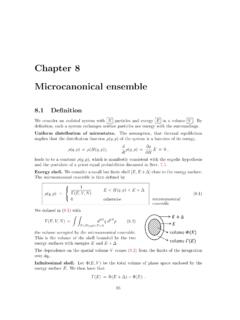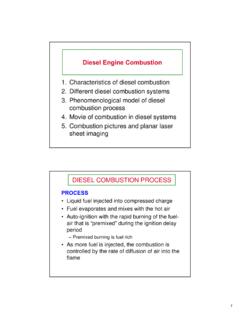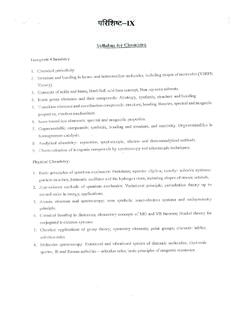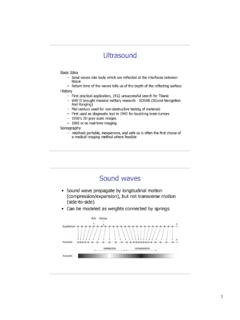Transcription of Chapter 6 Phase transitions - uni-frankfurt.de
1 Chapter 6. Phase transitions concept of Phase Phases are states of matter characterized by distinct macroscopic properties. Typical phases we will discuss in this Chapter are liquid, solid and gas. Other important phases are superconducting and magnetic states. First and second order Phase transitions . States of matter come with their stability regions, the Phase diagram. The properties of the microscopic state change by de nition at the Phase boundary. This change is . discontinuous rst order for a Phase transition continuous second order The appropriate variables for Phase diagram of water are the pressure P and the temper- ature T . critical point : The rst-order Phase boundary between gas and liquid becomes second order right at the critical point. The two phases have then equal densities and speci c entropies (entropy per particle). There is no critical point for the liquid-solid transition. triple point : The point at which gas, liquid and solid coexist. 63. 64 Chapter 6. Phase transitions .
2 Skating on ice. The melting curve of water has negative slope. Ice does hence melt at constant temperature T < T0 when increasing the pressure P . This happens during skating on ice. First-order Phase transition When water starts boiling, it undergoes a Phase transition from a liquid to a gas Phase . For both phases independently, the equation of state is a well-de ned regular function, continuous, with continuous derivatives. However, while going from liquid to gas one function abruptly changes to the other function. Such a transition is of rst-order. Gibbs enthalpy. Phase transitions in the P T Phase diagram are described by the Gibbs enthalpy G(T, P, N ), as de ned by ( ), which is itself a function of the pressure P and of the temperature T . G(T, P, N ) changes continuously across the Phase boundary when the transition is of rst order. The entropy S and volume V , which are given by the derivatives . G G. S = , V = , dG = SdT + V dP + dN. T P P T. of the Gibbs potential, are in contrast discontinuous.
3 Latent heat. Let us consider an instead of the P T the P V diagram, which is a projection of the equation of state for water. Two phases 1 and 2 coexisting at a temperature T0 have di erent entropies S1 and S2 . The system must therefore absorb or release heat, the latent heat QL , QL = T0 (S2 S1 ) , during a Phase transition of rst order. Condition for Phase coexistence We consider a system composed by one species of particles at given conditions of P and T (constant). Let us assume coexistence of two phases in our system. In this case, the FIRST-ORDER Phase TRANSITION 65. Gibbs potential is the sum of Gibbs potentials of the two phases, G(T, P, N ) = G1 (T, P, N1 ) + G2 (T, P, N2 ). = N1 1 (T, P ) + N2 2 (T, P ) , where we have used the Gibbs-Duhem relation ( ). Ni and i are the number of particles and the chemical potential in Phase i and N = N1 + N2 . Principle of minimal Gibbs energy. The principle of minimal Gibbs energy discussed in Sect. states that Gibbs potential has to be at its minimum, dG = 0, when P , T and N = N1 + N2 are xed.
4 G has to be therefore in equilibrium with respect to particle transfer from one Phase to the other. This implies that dG = 1 dN1 + 2 dN2 = 0, 1 (T, P ) = 2 (T, P ) , ( ). with dN1 = dN2 . The condition of coexistence ( ), tells us that the two phases 1 and 2 must have identical chemical potentials. Clausius-Clapeyron equation We denote the discontinuities across the Phase boundary with G = G2 (T, P, N1 ) G1 (T, P, N2 ) ( ).. ( G) ( G). S = S2 S1 = , V = V2 V1 = , T P P T. where we assume that S2 > S1 . Cyclic chain rule. The discontinuities G, S and V are functions of V , T and P , which are in turn related by the equation of state f (P, V, T ) = 0. There must hence exist a function f such that f ( G, T, P ) = 0 . This condition allows to apply the cyclic chain rule discussed in Sect. It leads to . ( G) T P. = 1 , ( ). T P P G ( G) T.. S 1/ V. 66 Chapter 6. Phase transitions . where we have used ( ). Vapor pressure. We note that P is the vapor pressure (Dampfdruck) for the gas-liquid transition.
5 It changes with temperature along the Phase transition line as . dP P. , ( ). dT T G=0. where we have used with G = 0 when the two phases are in equilibrium with each other. ( P/ T ) G= 0 is hence slope of the transition line in the P T diagram. The slope P/ T along the solid-liquid interface is positive when the substance contract upon freezing, the standard situation. Water does however expands upon freezing due to the Hydrogen bonding between molecules. P/ T is in this case negative. Clausius-Clapeyron relation. We rewrite ( ) as . dP S dP QL. = , = , ( ). dT G=0 V dT T V. where QL = T S is the latent heat. All quantities entering the Clausius-Clapeyron relation ( ) can be measured. It can be used either as a consistency check or to determine the latent heat Q by measuring T , V and the slope dP/dT . Second order transitions . In a second-order Phase transition the rst derivatives of G. vanish and the Clapeyron equation is replaced by a condition involving second derivatives. Ehrenfest classi cation of Phase transitions For the following discussion, let us denote the two phases in equilibrium at a given co- existence curve as and.
6 Following Ehrenfest we de ne next the order of the Phase transition. The order of the lowest derivative of the Gibbs enthalpy G. showing a discontinuity upon crossing the coexistence curve is the order of a Phase transition. EHRENFEST CLASSIFICATION OF Phase transitions 67. This de nition quanti es the preliminary discussion of Sect. Phase transitions of order n. Explicitly, a Phase transition between phases and . is of order n if m m m m . G G G G . = , =. T m P T m P P m T P m T. for m = 1, 2, .. , n 1 and if n n . G G n G n G . n = , =. T P T n P P n T P n T. In practice, only Phase transitions of rst- and second-order are of importance. Their properties are listed below. 1st order: 1) G(T, P ) continuous;.. G G. 2) S = and V = discontinuous;. T P P T. 3) latent heat. 2nd order: 1) G(T, P ) continuous;. 2) S(T, P ) and V (T, P ) continuous;. 3) the discontinuities in the second order derivative of G(T, P, N ) leads to discontinu- ities of the response functions 2 . S G. CP = T = T.
7 T P T 2 P.. 1 V 1 2G. T = = . V P T V P 2 T. 2 . 1 V 1 G. = =. V T V T P. (susceptibilities) across the transition Here we have used the de nition ( ) for the heat CP at constant pressure. T is the isothermal compressibility, the thermal expansion coe cient, as de ned in Sect. , and dG = SdT + V dP + dN . 68 Chapter 6. Phase transitions . Speci c heat jump. Phase transitions of the second order show a nite discontinuity in the speci c heat CP . An example is the transition to a superconducting state a at zero magnetic eld H. Diverging correlation length at criticality. The Ehrenfest classi cation is only valid if the motion of far away particles is not correlated, viz that the correlation length is nite. The correlation length diverges however at criticality for second order Phase transition when T Tc . This leads in turn also to diverging response functions. The magnetic susceptibility of a magnetic system diverges as . M 1. = , (T ) , ( ). H T (T Tc ) . where is the critical exponent.
8 Critical exponents are evaluated using advanced statis- tical mechanics methods, such as the renormalization group theory. Note, however, that ( ) is observed in most cases only very close to the transition. The entropy for a discontinuous transition. Discounting the exact order of transition we may classify a Phase transition in any case with regard to the continuity of the entropy. For a discontinuous transition we have: (i) S = 0 ; latent heat;. 2 . (ii) CP = T TG2 is nite for T = T0 ; no condition exists for T = T0 . P. The entropy for a continuous transition. In this case we nd: (i) S continuous no latent heat;. (ii) critical point Tc ;. (iii) singularities in CV , T , T. Density jumps. Consider a uid system for which the volume V = ( G/ P )T shows a nite discontinuity V at a 1st order Phase transition, such as the liquid-gas line below the critical point. The corresponding densities particle density = N/V is then likewise discontinuous. VAN DER WAALS EQUATION OF STATE 69. The density jump diminishes along the liquid-gas transition line, when the temperature is increased, until it vanishing at Tc.
9 The transition becomes continuous at the critical point T = Tc . Spontaneous magnetic ordering. The magnetization M of a magnetic compound is in part induced by an external magnetic eld and in part due to the spontaneous ordering, viz by the alignment of the microscopic moments. The magnetic work entering the internal energy dU = Q + W is W = HdM , as de ned by ( ). With the Gibbs enthalpy G(T, H) being the (two-fold) Legendre transform of the internal energy U (S, M ), we then have that . G. M = , dG = SdT M dH . H T. The magnetization M is discontinuous when spontaneous ordering is present, when the transition is of 1st order. Following the transition line, by increasing the temperature T Tc , the jump 2Ms decreases until spontaneous ordering disappears and the Phase transition becomes second-order at T0 = Tc . Van der Waals equation of state The equation of state for an ideal gas, P V = N kB T, P V = nRT , ( ). is only valid for very small densities of particles and, therefore, cannot describe the gas- liquid Phase transition.
10 This Phase transition is due to intermolecular interactions. In 70 Chapter 6. Phase transitions . this section, we will derive an equation of state for a gas which includes intermolecular interaction in a phenomenological way. Renormalized ideal gas. We consider with Pef f Vef f = nRT ( ). the ansatz that a gas of interacting molecules still obeys the ideal gas equation of state ( ), albeit with yet to determine e ective variables, where the e ective pressure and temperature, Pef f and Tef f , are are functions of the physical pressure P and temperature T respectively. One can regard ( ) as a renormalized ideal gas equation of state. Interaction potential. The interaction between molecules is generically composed of a repulsive core (due to the Fermi repulsion between the electrons) and an attractive tail (due to the van der Waals dipole-dipole interaction). The depth of the attractive U (r) is about 1 eV (changes with the gas species). This minimum is responsible for the chemical valence and for the crystal structure of solids.








